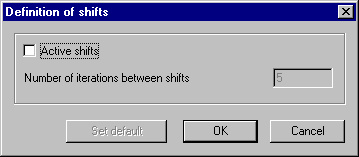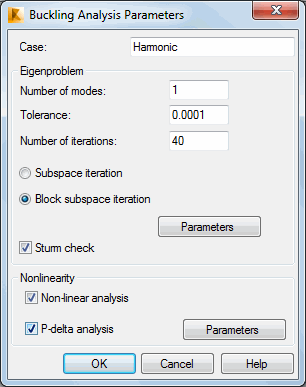The method of block subspace iteration is used to solve the generalized eigenproblem
![]() ( 1 )
( 1 )
These are faced during modal or buckling analysis of a structure. The above-presented formula assumes the symbols refer to the following entities:
K - Stiffness matrix
B = M - mass matrix in the case of dynamic analysis; in the remaining cases B = Ks
where Ks is the stress-stiffness matrix, originating in the linearization of the appropriate non-linear operator in the case of buckling analysis
λ - Eigenvalue
Φ - Eigenvector.
The method of block subspace iteration is preferred when obtaining a considerable number of eigenpairs (eigenvalues and eigenvectors) for a structure. Usually this is more than ten.
If the method of block subspace iteration is used, all types of mass matrices (consistent, lumped with rotations, lumped without rotations) may be selected. The range of application of is limited to the modal analysis. Selecting Lanczos makes available the remaining two modes, pseudo-modal and seismic.
If Sturm check is active, it will be performed during verification process to determine the skipped eigenvalues.
The method of block subspace iteration consists in simultaneous iterations of a vector in subspace with a determined dimension. Each vector for which the process of convergence has been performed is removed from the working subspace and a new start vector is added in its place. Orthogonality of the vectors is assured in each iterative step. The following convergence criterion is applied:
![]() ( 2 )
( 2 )
where:
i, k - number of a mode and number of iteration step, respectively
tol -tolerance, defined in the "Tolerance" edit field.
One should notice the fact that the results of modal and buckling analyses are determined with certain precision, determined by the following formula:
 ( 3 )
( 3 )
If the process of convergence is slow, it is recommended to apply the procedure of shifts in modal analysis:
![]() ( 4 )
( 4 )
where:
Kσ = K - σ M,
σ - shift value.
Click Define Parameters to define parameters of the shifting procedure. If Active shifts option is deselected, the procedure will be activated. The number of iterations between two successive shifts is treated as the parameter of this procedure.

Click Set default to assume the default value of the iteration number. If the method with shifts is to be used, deselect Active shifts and click OK.
The shifting procedure should not be applied to the analysis of buckling problems because there is a danger of shifting the spectra of eigenvalues in the direction of negative critical load (possibly disregarding positive critical loads) when there are negative eigenvalues for the structure.
To select the method of block subspace iteration for buckling analysis of a structure, click Change analysis type in the Analysis Type dialog (for the selected load case) and select the Buckling option in the Analysis Type Change dialog. Click OK to access the parameters dialog for buckling analysis and select the block subspace iteration method.

Determined eigenpairs are sorted in the following manner | λ1 | ≤ | λ 2 | ≤ ... ≤ | λ n |, which results in locating the minimum parameters of critical load in the upper part of the table with results.
See also: